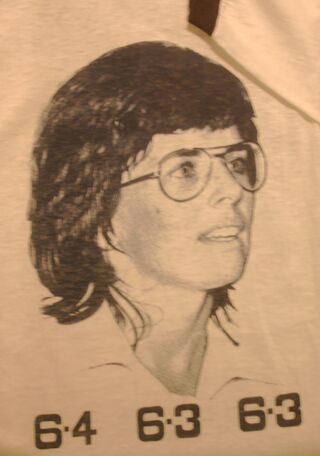Play
The Epic “Battle of the Sexes”
When gender, play, and competition took center court.
Posted October 31, 2022 Reviewed by Hara Estroff Marano
Key points
- A famous tennis match set the stage for profound cultural change.
- Play can encompass both serious business and playful clowning.

Nearly a half-century ago, at that tipping point when consciousness-raising turned to concrete demands, and during the short span when “women’s liberation” matured into “the women’s movement,” Bobby Riggs, the past triple-crown Wimbledon winner turned court jester, challenged Billy Jean King to a match that the media called a “battle of the sexes.”
The Lobber v. the Libber
For years, the trick-shot artist had made his living hustling lesser but richer tennis opponents by offering to even the odds with outrageous handicaps—a chair or two and a sofa set up as obstacles in his court. Riggs, who titled his autobiography Tennis Is My Racket, had promised King that they would make a bundle on a public spectacle, but King, busy with organizing the budding Women’s Tennis Association and aware of the risk of a loss, demurred. Riggs then sought out Margaret Smith Court for his boy v girl sports drama.
With tactics like his confusing space-shot lobs, Riggs bested Court in a $10,000 winner-take-all contest. Riggs’ hooting about this “Mother’s Day Massacre,” his loud self-advertisement that he was a “male chauvinist pig,” and his pre-match public vitamin-gobbling to minimize the age difference, had with this first victory put the ball in King’s court and maneuvered her into the offer she couldn’t continue to refuse.
With a hundred thousand dollars at stake, the televised match did prove to be the richest tennis purse of all time. But for King, the stakes lay elsewhere. She knew that her humiliation at his hands could endanger the precarious foothold of the new Title IX provisions for equal treatment for men and women in American sport. Having accorded the hoopla a higher priority than practice and conditioning, Riggs arrived not just out of shape but also seriously out of step.
The Matchup and the Match
Having none of the foolishness that perplexed Bobby Riggs’ other opponents, the hard-charging 29-year old beat Riggs at his own game of spin and tricks, outsmarting him as much as outpacing him. Alternating her shots left and right, shallow and deep, King ran Riggs ragged from side to side and corner to corner returning the volleys.
Ahead at first but then tiring, the 55-year-old Riggs lost the first set 6-4. When Billie Jean King drove home her advantage decisively in the following set, winning it 6 games to 3, television commentator Howard Cosell sensed a romp and began to ease away from his mock disapproval of the comic bad guy. And when she demolished Riggs in the last set, Cosell began to murmur in respectful tones about the once-great player. The sideshow, the pseudo-event, had become a variety of the real thing, a “dazzling clinical exhibition of tennis” according to the Sports Illustrated reporter.
It is rare to hear the music of the cultural spheres hum so clearly as the paradigms shift, but that afternoon on the floor of the Astrodome was one of those times.
That match exposed instructive truths not only about the way we build our assumptions about gender but also about the nature of play itself. A carnival atmosphere had prevailed beforehand at the Astrodome, with Riggs hauled around on a rickshaw by photographers’ models and King borne aloft, like Cleopatra, on a sedan chair by football players in skimpy togas.
The Game Face v the Play Face
But when King walked onto the court, the professional’s no-nonsense determination showed with the set of her jaw. Many of the 30,000 court-side fans, and 90 million watchers worldwide could see it plainly in her face. She had come to play. It began to appear that Bobby Riggs, though armed with a wisecrack and a smirk for all who had gathered court-side beforehand at the practice sessions, likeable despite his retrograde guise, had shown up only to fool around. These two figures at that moment contained in the way they carried themselves the paradoxes of play at its polar opposites.
Though sports commentators’ claims that they can spot a winner by his look usually come ex post facto, they still are on to something important. If the eyes are windows into the soul, it’s the face that outwardly expresses our state of mind. The blush, the smile, the grimace, the pout, and the snarl signal embarrassment, amusement, pain, distress, or anger, not for our own benefit, since we already know what we’re feeling, but for others who may profit from the forewarning.
Distinguishing Play from Threat
Primatologists have no trouble picking out the “play face” among our close first-cousins, especially the chimpanzees, who though their facial repertoire is limited, signal play much as we do, with wide eyes, round mouth, and gleeful hooting. We have all seen that very face on the playground, among humans, particularly among boys who signal the rules of friendly rough and tumble.
Without hearing a word exchanged we know the bullies, too, by their narrowed stare and clenched teeth. They don’t “get” social play. The play face, a mixture of glee, mischief, determination, and surprise on the outside accurately reveals a state of consciousness inside. Because we evolved as social beings, understanding our fellows’ moods paid survival dividends over the evolutionary long haul. And, from understanding, it is only a short leap to inferring intent.
Generating this “theory of mind”—a grasp of the independent conscious agency of others—is a crucial step in the development of the young child as a social being. Considered again from the perspective of our species' history, it must have been especially handy to distinguish between play and threat. Presumably we don’t count many among our ancestors who couldn’t tell the two apart.
Competition v Clowning
Bobby Riggs perfected a play face that contained all the buffoonery that a tennis hustler needed to keep his marks entertained. A calculating intellect lay behind the grin, of course. His opponents needed to feel cheerful while losing. But the result was the goofy, irreverent, spontaneous clown at center court, happily bucking the rising tide for women’s equality. Billie Jean King, clearly the better competitor, and 26 years younger, was yet more serious, her pre-match conditioning infused with the stern resolve to avoid defeat.
Clearly their purposes diverged, he toward cadging commercial endorsements and a long shot at the prize money, she for her larger cause, commensurate respect, and equal pay for equal work.
References
Simon Baron-Cohen, “Precursors to a Theory of Mind: Understanding Attention in Others,” in Andrew Whiten, ed., Natural Theories of Mind: Evolution Development and Simulation of Everyday Mindreading, (1991).
Curry Kirkpatrick, “There she is, Ms. America,” Sports Illustrated, (October 1, 1973).
Anthony D. Pelligrini, “Elementary School Children’s Rough-and-Tumble Play,” Early Childhood Research Quarterly, 4, (1989), pp. 245-260; and Pelligrini, “Boys Rough and Tumble Play and Social Competence: Contemporaneous and Longitudinal Relations,” in The Future of Play Theory, Anthony D. Pelligrini, ed., (1995).
Susan Ware, Game, Set, Match: Billie Jean King and the Revolution in Women’s Sports, (2011).
Bobby Riggs, Tennis is My Racket, (1949).




